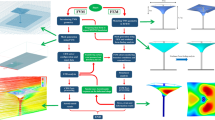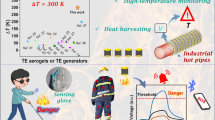Abstract
High heat flux generation in electronic devices demands new modes, methods and structures to dissipate heat effectively. We investigate the thermal performance of cellular structures using computational fluid dynamics (CFD) and obtained an optimal cellular structure for effective heat dissipation. Then, we validate our numerical results with experimental results obtained using optimized cellular structure. We found the minimum base temperature for the optimized cellular structure to be 43.6 °C and 47.4 °C numerically and experimentally respectively at inlet velocity of 10 m/s. We carried out experiments and simulations at the heat flux of 35,503 W/m2. We found a close agreement between numerical and experimental results with an error of 8.71% for the base temperature. Previously the best base temperatures were reported to be 55 °C and 40.5 °C using air and water respectively [1, 2].














Similar content being viewed by others
Abbreviations
- Ab :
-
Frontal blocked area (m2)
- At :
-
Frontal total area (m2)
- As :
-
Surface Area (m2)
- b:
-
Length of square side (mm)
- c:
-
Centre to centre distance (mm)
- Cp :
-
Specific heat (kJ/kgK)
- d:
-
Bore diameter (mm)
- dh :
-
Hole diameter (mm)
- H:
-
Height (mm)
- Kcell :
-
Pressure loss coefficient
- L:
-
Length (mm)
- ṁ:
-
Mass flow rate (kg/s).
- ΔP:
-
Pressure Difference (Pa).
- p:
-
Pressure (Pa)
- Q̇:
-
Heat transfer rate (W)
- RBR :
-
Blockage ratio
- ROPEN :
-
Open area ratio
- T:
-
Temperature (°C)
- Tb :
-
Base temperature (°C)
- Ti :
-
Inlet Temperature of air (°C)
- To :
-
Outlet Temperature of air (°C)
- t:
-
Wall thickness (mm)
- u:
-
Velocity in x (m/s)
- vi :
-
Inlet velocity (m/s)
- vo :
-
Outlet velocity (m/s)
- V:
-
Volume of the structure (m3)
- Vb :
-
Total volume of whole solid block (m3)
- W:
-
Width (mm)
References
Mohammed MM, Abd El-Baky MA (2013) Air cooling of mini-channel heat sink in electronic devices. J Electron Cool Thermal Contrl 3:49–57
Jajja SA, Ali W, Ali HM, Ali AM (2014) Water cooled minichannel heat sinks for microprocessor cooling: effect of pin spacing. Appl Therm Eng 64:76–82
Shoukat AA et al (2018) Stability of nano-fluids and their use for thermal management of a microprocessor: an experimental and numerical study. Heat Mass Transf
Duangthongsuk W, Wongwises S (2018) A comparison of the thermal and hydraulic performances between miniature pin fin heat sink and microchannel heat sink with zigzag flow channel together with using nanofluids. Heat Mass Transf: 1–10
Lin SJ, Chen YJ (2016) Theoretical determination of design parameters for an arrayed heat sink with vertical plate fins. Heat Mass Transf 52(5):1051–1060
Gochman S et al (2003) The Intel Pentium M processor: micro architecture and performance. Int Technol J 7:21–36
Ashby MF et al. (2000) Metal foams: a design guide, butterworth-heineman. Boston, MA, USA
Kaviany M (1995) Principles of heat transfer in porous media. Springer, New York
Seyf H, Layeghi M (2010) Numerical analysis of convective heat transfer from an elliptic pin fin heat sink with and without metal foam insert. J Heat Transf 132
C. T. DeGroot, A. G. Straatman, and L. J. Betchen, "Modeling forced convection in finned metal foam heat sinks. Journal of Electronic Packaging-Transactions of the ASME, vol. 131, 2009
Zhao CY, Kim T, Lu TJ, Hodson HP (2002) Modeling on thermal transport in celleular metal foams. J Thermofluid Phys. (in press)(also in:8th Joint AIAA/ASME Thermophysics and Heat Transfer Conference, AIAA,
Hwang J, Hwang G, Yeh R, Chao C (2002) Measurement of interstitial convective heat transfer and frictional drag for flow across metal foams. J Heat Transf 124:120–129
Evans AG, Hutchinson JW, Fleck NA, Ashby MF, Wadley HNG (2001) The topological design of multifunctional cellular metals. Prog Mater Sci 46:309–327
Tian J et al (2004) The effects of topology upon fluid-flow and heattransfer within cellular copper structures. Int J Heat Mass Transf 47:3171–3186
Tian J et al. (2004) The effects of topology upon fluid-flow and heat transfer within cellular copper strucutres. Int J Heat Mass Transf: 16
Zhao C (2012) Review on thermal transport in high porosity cellular metal foams with open cells. Int J Heat Mass Transf 55:3618–3632
Lu TJ (2002) Ultralight porous metals:from fundamentals to applications. Acta Mech Sinica 18:457–479
Gu S, Lu TJ, Evans AG (2001) On the design of two-dimensional cellular metals for combined heat dissipation and structural load capacity. Inter J Heat Mass Transf 44:2163
Kim SY, Paek JW, Kang BH (2003) Thermal performance of aluminum foam heat sinks by forced air cooling. IEEE Trans Compo Pack Technol 26(1):262–267
Bastawros AF, Evans AG, Stone HA (1998) Evaluation of cellular metal dissipation media. Technical Report MECH,
Mancin S, Zilio C, Diani A, Rossetto L (2012) Experimental air heat transfer and pressure drop through copper foams. Exp Thermal Fluid Sci 36:224–232
Zhang H, Chen L, Liu Y, Li Y (2013) Experimental study on heat transfer performance of lotus type porous copper heat sink. Int J Heat Mass Transf 56:172–180
Lu TJ (1999) Heat transfer efficiency of metal honeycombs. Int J Heat Mass Transf 42:2031–2040
Bhattacharya A, Mahajan RL (2002) Finned metal foam heat sinks for electronics cooling in forced convection. J Electron Pack 124:155–163
Xu S, Yang L, Li Y, Wu Y, Hu X (2016) Experimental and numerical investigation of heat transfer for two-layered microchannel heat sink with non-uniform heat flux conditions. Heat Mass Transf 52(9):1755–1763
Tang B et al (2017) Heat transfer performance of a novel double-layer mini channel heat sink. Heat and Mass Transfer 53(3):929–936
Rafati M, Hamidi AA, Niaser MS (2012) Applications of nanofluids in computer cooling systems (heat transfer performance of nanofluids). Appl Therm Eng 45-46:9–14
Kline SJ, McClintock FA (1953) Describing uncertainties in single-sample experiments. Mech Eng 75:3–8
Tian J, Lu TJ, Hodson HP, Queheillalt DT, Wadley HNG (2007) Cross flow heat exchange of textile cellular metal core sandwich panels. J Heat Mass Transf 50:2521–2536
Author information
Authors and Affiliations
Corresponding author
Additional information
Publisher’s Note
Springer Nature remains neutral with regard to jurisdictional claims in published maps and institutional affiliations.
Rights and permissions
About this article
Cite this article
Tariq, H.A., Israr, A., Khan, Y.I. et al. Numerical and experimental study of cellular structures as a heat dissipation media. Heat Mass Transfer 55, 501–511 (2019). https://doi.org/10.1007/s00231-018-2439-7
Received:
Accepted:
Published:
Issue Date:
DOI: https://doi.org/10.1007/s00231-018-2439-7




